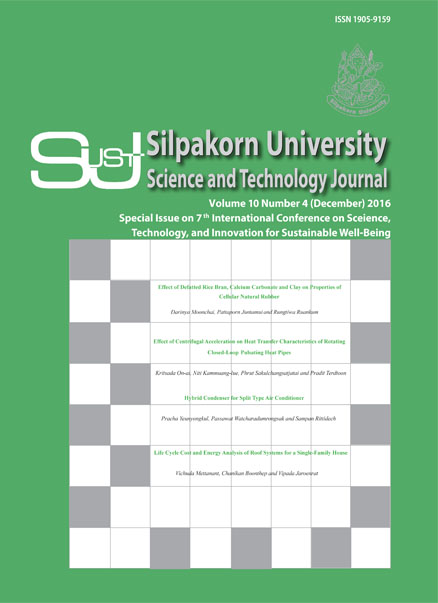Effect of Defatted Rice Bran, Calcium Carbonate and Clay on Properties of Cellular Natural Rubber
Main Article Content
Abstract
The effects of defatted rice bran (DRB) as a filler for cellular natural rubber (NR) vulcanizate on its cell morphology, water absorption and mechanical properties were investigated. The properties of the DRB-filled cellular NR vulcanizate were also compared with clay-filled and CaCO3-filled cellular NR vulcanizates at similar loading level (30 parts per hundred of rubber). Scanning electron micrographs revealed that the greater cell size was observed when cellular NR vulcanizates were filled with all types of filler. The DRB-filled cellular NR vulcanizate exhibited better and more uniform dispersion of cellular cell structure as compared to CaCO3-filled and Clay-filled cellular NR vulcanizates.Moreover,the DRB-filled cellular NR vulcanizate gave the highest water absorption value, tensile strength and 100%modulus as compared to CaCO3-filled and Clay-filled cellular NR vulcanizates. The elongation at break of DRB-filled cellular NR vulcanizate was found to be comparable to that of CaCO3-filled cellular NR vulcanizate. However, the cellular NR vulcanizate filled with DRB showed the lowest hardness value.According to these observations, DRB can potentially be used as acheap and more environment-friendly natural filler for cellular natural rubber.
Downloads
Article Details
References
Lin, G., Zhang, X. J., Liu, L., Zhang, J. C., Chen, Q. M. and Zhang, L. Q. (2004). Study on microstructure and mechanical properties relationship of short fibers/ rubber foam Composites. European Polymer Journal, 40: 1733-1742.
Moonchai, D., Juntamui, P., and Ruankum, R. (2015). Utilization of defatted rice bran as a filler for cellular natural rubber. Rajamangala University of Technology Isan Journal, Special Issue 1:451-457
Moonchai, S. and Moonchai, D. (2013). Modelling and optimization of rebound resilience and hardness of defatted rice bran/calcium carbonate-filled NR vulcanisates. Polymer Testing, 32: 1472-1478.
Moonchai, D., Moryadee, N. and Poosodsang, N. (2012). Comparative properties of natural rubber vulcanisates filled with defatted rice bran, clay and calcium carbonate. Maejo International Journal of Science and Technology, 6(2): 249-258
Ruiz-Herrero, J. L., Rodriguez-Perez, M. A. and De Saja, J. A. (2005). Design and construction of and instrumental falling weight impact tester to characterise polymer-based foams. Polymer Testing, 24: 641-647.
Sims, G. L. A. and Bennett, J. A. (1998). Cushioning performance of flexible polyurethane. Polymer Engineering & Science, 38(1): 134-142.
Srilathakutty, R., George, K. E. and Joseph, R. (2002). Rice hull ash as a filler in microcellular soles.International Journal of Environmental Studies, 59(1): 133-142.
Wang, B., Peng, Z., Zhang, Y. C. and Zhang, Y. (2007). Compressive response and energy absorption of foam EPDM. Jounal of Applied Polymer Science, 105: 3462-3469.
Wimolmala, E., Khongnual, K. and Sombatsompop, N.(2009). Mechanical and morphological properties of cellular NR/SBR vulcanizates under thermal and weathering ageing. Jounal of Applied Polymer Science, 114:136-147.
Zhang, J., and Ashby, M. F. (1994). Mechanical selectionof foams and honeycombs used for packaging and energy absorption. Journal of Materials Science, 29: 157-163.


